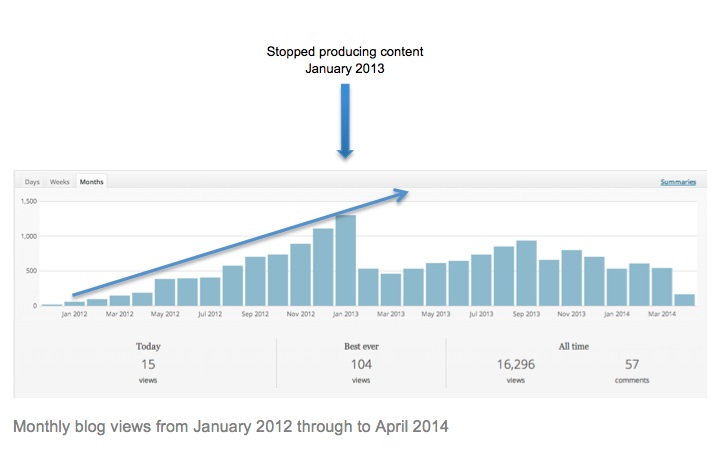The average customer consults 10 pieces of content prior to purchase.
People want to be sure about a business’s credentials and a product’s effectiveness before they shell out, and Google has made researching that much easier. A recent study by the Chief Marketing Officer Council found that most buyers seek neutral, third party, fact-driven content, and that 68% of searchers start their hunt with search engines and go on to check social media and other third-party sites.
When searching for content sources that match a searcher’s enquiry (for example, ‘Corporate catering in Berkshire’), the search engines will favour regularly updated websites and portals with fresh content.
In order to cater for their prospective buyers’ thirst for information and endorsements, vendors need to produce plenty of content and regularly distribute it across multiple platforms – but which platforms, what kind of content, and how regularly?
Real life case study
20x increase in monthly blog views over 12 months
Two years ago we set up and managed a blog, a Twitter account and a Facebook page for a local furniture provider. We tweeted between 5-10 times day, scheduling tweets to go out at the optimal times for its audience.
We produced 4-5 blog posts per month based around the interests of the audience, with keyword-rich posts ranging from light interest pieces to instructional guides like ‘How to assemble your furniture’.
We regularly monitored Facebook and Twitter in order to respond to enquiries and share positive feedback from customers on the client’s various platforms where prospective buyers could see it.
After six months, monthly blog traffic had increased 7x. After a year, this increase was almost 20x. The client was receiving regular enquiries through its new platforms, and engaging in conversations with audiences who it simply hadn’t been able to reach online before.
Blog views were converting into website views, and the content we were producing was boosting its web presence and raising its brand awareness, by providing multiple content touch-points for prospective customers. We tracked breakdowns of the views, how visitors found the blog, and what search terms they used.
The effect of reducing content
After 12 months the client had to unexpectedly cut its sales and marketing budget, and as a result could no longer afford to maintain its social media management and content production. The month we stopped producing content the blog reached an all-time high of 1,300 monthly views. What happened next was startling.
Eight weeks after the content stopped, traffic to the blog had decreased by 60%. Over a year later, as content and management waned, so have blog visits and audience engagement.
Although some people are still finding the blog organically through the search engines thanks to the existing keyword rich content, the client has missed an opportunity to grow its business.
These results demonstrated the importance of maintaining regular relevant content, and yet many businesses don’t know where to start.
So how do you deliver regular, relevant content to the right audience?
Decide what your goals are: who do you want to engage, and what do you want them to do – visit your website? Download a whitepaper? Request a brochure?
Research where this audience is reachable (social media, for example), how they like to be talked to and what kinds of content they like to consume (listicles, videos, articles).
The next step is to decide what platforms you’re going to use (e.g Twitter, Facebook, Google+, Blog), what kind of content to post, and how regularly. Plan a 6-month calendar of content based around industry news, customer reviews, product guides or other ideas – and decide who will be responsible for producing it.
This may sound quite a lot to manage if you’re handling your marketing in house. Many of our clients use us as an extension of their marketing department, to provide them with regular relevant content and distribute it through the appropriate channels, to give them the peace of mind that they’re maintaining their web presence and targeting the right audiences.







